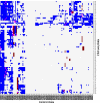WACS: improving ChIP-seq peak calling by optimally weighting controls
- PMID: 33588754
- PMCID: PMC7885521
- DOI: 10.1186/s12859-020-03927-2
WACS: improving ChIP-seq peak calling by optimally weighting controls
Abstract
Background: Chromatin immunoprecipitation followed by high throughput sequencing (ChIP-seq), initially introduced more than a decade ago, is widely used by the scientific community to detect protein/DNA binding and histone modifications across the genome. Every experiment is prone to noise and bias, and ChIP-seq experiments are no exception. To alleviate bias, the incorporation of control datasets in ChIP-seq analysis is an essential step. The controls are used to account for the background signal, while the remainder of the ChIP-seq signal captures true binding or histone modification. However, a recurrent issue is different types of bias in different ChIP-seq experiments. Depending on which controls are used, different aspects of ChIP-seq bias are better or worse accounted for, and peak calling can produce different results for the same ChIP-seq experiment. Consequently, generating "smart" controls, which model the non-signal effect for a specific ChIP-seq experiment, could enhance contrast and increase the reliability and reproducibility of the results.
Result: We propose a peak calling algorithm, Weighted Analysis of ChIP-seq (WACS), which is an extension of the well-known peak caller MACS2. There are two main steps in WACS: First, weights are estimated for each control using non-negative least squares regression. The goal is to customize controls to model the noise distribution for each ChIP-seq experiment. This is then followed by peak calling. We demonstrate that WACS significantly outperforms MACS2 and AIControl, another recent algorithm for generating smart controls, in the detection of enriched regions along the genome, in terms of motif enrichment and reproducibility analyses.
Conclusions: This ultimately improves our understanding of ChIP-seq controls and their biases, and shows that WACS results in a better approximation of the noise distribution in controls.
Keywords: Bias; ChIP-seq; Controls.
Conflict of interest statement
The authors declare that they have no competing interests.
Figures






Similar articles
-
RECAP reveals the true statistical significance of ChIP-seq peak calls.Bioinformatics. 2019 Oct 1;35(19):3592-3598. doi: 10.1093/bioinformatics/btz150. Bioinformatics. 2019. PMID: 30824903 Free PMC article.
-
Unified Analysis of Multiple ChIP-Seq Datasets.Methods Mol Biol. 2021;2198:451-465. doi: 10.1007/978-1-0716-0876-0_33. Methods Mol Biol. 2021. PMID: 32822050
-
Comparative analysis of commonly used peak calling programs for ChIP-Seq analysis.Genomics Inform. 2020 Dec;18(4):e42. doi: 10.5808/GI.2020.18.4.e42. Epub 2020 Dec 14. Genomics Inform. 2020. PMID: 33412758 Free PMC article.
-
ChIP-R: Assembling reproducible sets of ChIP-seq and ATAC-seq peaks from multiple replicates.Genomics. 2021 Jul;113(4):1855-1866. doi: 10.1016/j.ygeno.2021.04.026. Epub 2021 Apr 18. Genomics. 2021. PMID: 33878366
-
Theoretical characterisation of strand cross-correlation in ChIP-seq.BMC Bioinformatics. 2020 Sep 22;21(1):417. doi: 10.1186/s12859-020-03729-6. BMC Bioinformatics. 2020. PMID: 32962634 Free PMC article.
Cited by
-
Benchmarking transcription factor binding site prediction models: a comparative analysis on synthetic and biological data.Brief Bioinform. 2025 Jul 2;26(4):bbaf363. doi: 10.1093/bib/bbaf363. Brief Bioinform. 2025. PMID: 40702706 Free PMC article.
-
F-Seq2: improving the feature density based peak caller with dynamic statistics.NAR Genom Bioinform. 2021 Feb 23;3(1):lqab012. doi: 10.1093/nargab/lqab012. eCollection 2021 Mar. NAR Genom Bioinform. 2021. PMID: 33655209 Free PMC article.
-
A SlRBP1-SlFBA7/SlGPIMT module regulates fruit size in tomato.Hortic Res. 2025 Mar 18;12(7):uhaf089. doi: 10.1093/hr/uhaf089. eCollection 2025 Jul. Hortic Res. 2025. PMID: 40352284 Free PMC article.
-
Transcriptional regulation by PHGDH drives amyloid pathology in Alzheimer's disease.Cell. 2025 Jun 26;188(13):3513-3529.e26. doi: 10.1016/j.cell.2025.03.045. Epub 2025 Apr 23. Cell. 2025. PMID: 40273909 Free PMC article.
-
CATA: a comprehensive chromatin accessibility database for cancer.Database (Oxford). 2020 Jan 17;2022:baab085. doi: 10.1093/database/baab085. Database (Oxford). 2020. PMID: 35134148 Free PMC article.
References
MeSH terms
Grants and funding
LinkOut - more resources
Full Text Sources
Other Literature Sources

